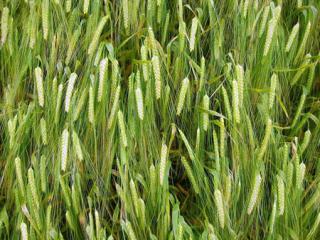Latest Briefing in Climate, water and energy

Integrated Disease Management in Spring Barley
Intergrated Disease Management (IDM) could help greatly reduce the volume of crops lost to disease in Scotland, contributing to our future food security. It works by integrating plant resistance, fungicides, cultural methods such as appropriate use of fertilisers, and newer, innovative approaches, to provide effective and sustainable disease control.
In Scotland, barley is the second most important crop after grass, with nearly 300,000 ha grown in 2012, with a net value of £315 million. Diseases represent a major constraint to barley production globally, despite considerable effort to control the pathogens responsible. The ability of pathogens to overcome host resistance, development of pathogen insensitivity to fungicides, and the increasing importance of pathogens thought previously to be of minor significance, means that diseases will continue to pose a threat to global barley production.
These constraints, coupled with increasing legislation aimed at protecting the environment, have led to increased efforts to find more sustainable approaches to disease control. Such approaches clearly need to balance protecting the crop from threats such as diseases, pests and weeds, with the need to minimise environmental damage, and requires an integrated approach to crop protection.
IDM represents such an approach and is a continuously improving process in which innovative solutions are integrated and adapted locally by growers. By offering a broad spectrum, integrated approach to disease control, IDM will contribute to reducing reliance on pesticides in agricultural systems.
Read morePublished on 16 December 2014 in Climate, water and energy , Ecosystems and biodiversity , Food, health and wellbeing
Recent Briefings in Climate, water and energy
Scotland's Water Resources: Impacts of Land Use and Climate Change
Scotland has water resources of generally high quality and with adequate volume to meet current demands. Read more
Published on 29 January 2013 in Climate, water and energy
Liver Fluke in Sheep and Cattle - A Major Animal Health Concern Following One of the Wettest UK Summers on Record
The summer of 2012 has been one of the wettest summers on record and it is held responsible for the extraordinary levels of disease and death in sheep due to liver fluke. Read more
Published on 24 January 2013 in Sustainability and Communities , Climate, water and energy , Food, health and wellbeing
Marine litter issues, impacts and action-contributing to a marine litter strategy for Scotland
Increasingly, policy makers and the public are experiencing the problem of litter in our seas and on our beaches. Read more
Published on 2 February 2012 in Sustainability and Communities , Climate, water and energy , Ecosystems and biodiversity
Putting 'Good Practice' in Context - Lessons for Catchment Management
In recent years, collaborative and cross-sectoral approaches have been recommended as the most effective and equitable way to achieve better water quality in catchments. Read more
Published on 6 December 2011 in Sustainability and Communities , Climate, water and energy , Ecosystems and biodiversity
Designing effective flood warning systems in Scotland
The risks from flooding can never be completely eliminated but the harm caused by floods can be greatly reduced or mitigated by effective flood warning systems. Read more
Published on 2 November 2011 in Climate, water and energy
River Basin Planning meets Spatial Planning
The EU Water Framework Directive (WFD), seen by many as a 'Sustainability Directive', strongly emphasises the need for closer ties between river basin management and land use planning. Read more
Published on 18 August 2011 in Climate, water and energy
Encouraging land-manager contributions to protecting and enhancing the water environment
The Scottish Government recognises water as a key resource that is . Read more
Published on 9 August 2011 in Climate, water and energy
New diagnostic test for endemic cattle disease under development
Johne's Disease caused by Mycobacterium avium subspecies paratuberculosis is endemic disease in cattle and its prevalence is increasing. Read more
Published on 16 February 2011 in Sustainability and Communities , Climate, water and energy , Ecosystems and biodiversity , Food, health and wellbeing
Impacts of volcanic ash originating from the eruption in Eyjafjallajökull (Iceland) on the natural resources of Scotland
The fall out of volcanic ash from the eruption of the Icelandic volcano Eyjafjallajökull caused significant travel disruption during April 2010 and raised specific concerns about the potential impacts on Scottish natural resources, such as (i) pastures and livestock; (ii) soils and (iii) surface water. Read more
Published on 8 February 2011 in Climate, water and energy , Ecosystems and biodiversity
The social benefits of reducing outcome-related risk in land-based climate change mitigation
There are three principle means of reducing emissions from agriculture: i) reducing emissions; ii) enhancing removals; and iii) displacing emissions. Read more
Published on 11 January 2011 in Climate, water and energy





